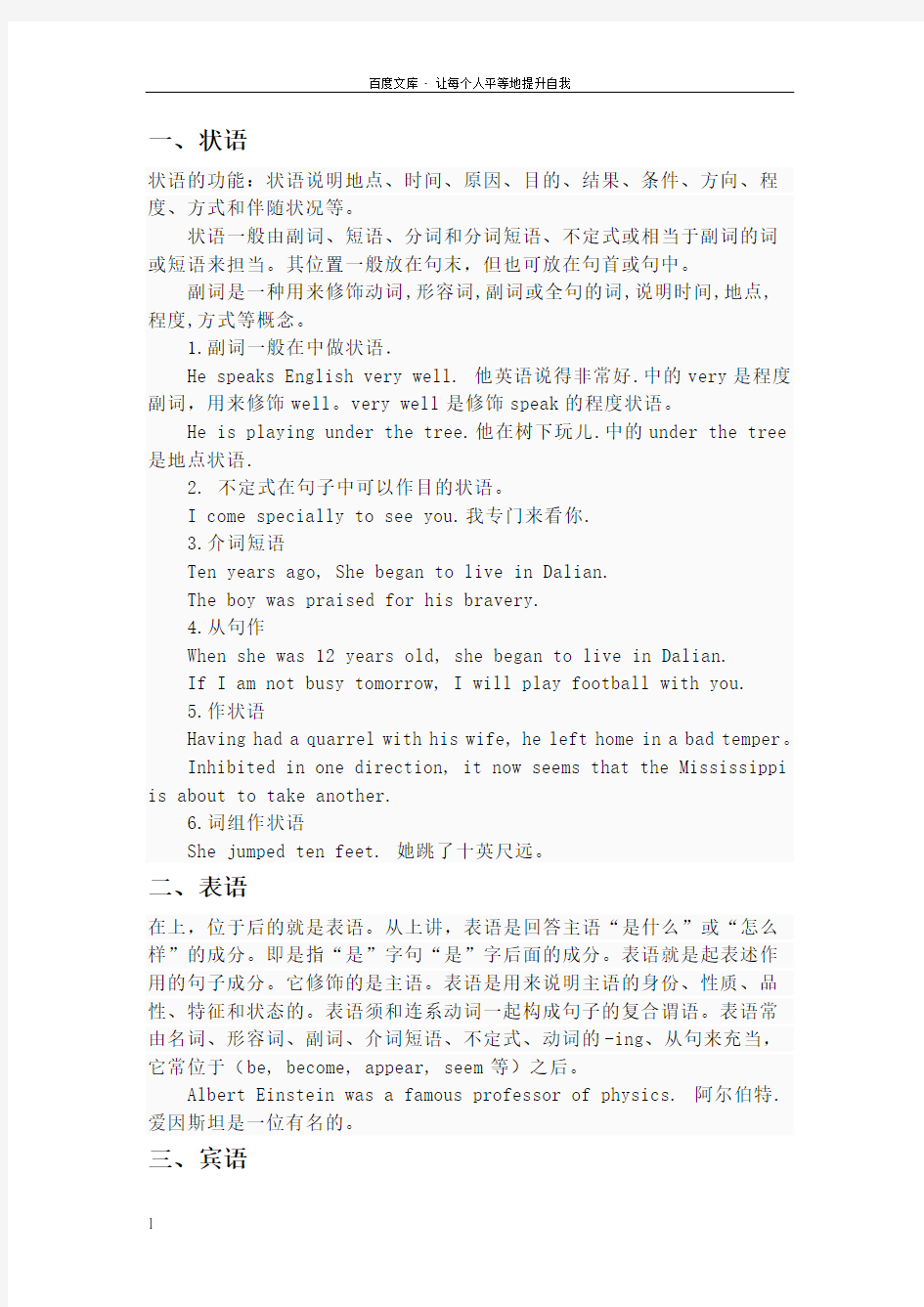

一、状语
状语的功能:状语说明地点、时间、原因、目的、结果、条件、方向、程度、方式和伴随状况等。
状语一般由副词、短语、分词和分词短语、不定式或相当于副词的词或短语来担当。其位置一般放在句末,但也可放在句首或句中。
副词是一种用来修饰动词,形容词,副词或全句的词,说明时间,地点,
程度,方式等概念。
1.副词一般在中做状语.
He speaks English very well. 他英语说得非常好.中的very是程度副词,用来修饰well。very well是修饰speak的程度状语。
He is playing under the tree.他在树下玩儿.中的under the tree 是地点状语.
2. 不定式在句子中可以作目的状语。
I come specially to see you.我专门来看你.
3.介词短语
Ten years ago, She began to live in Dalian.
The boy was praised for his bravery.
4.从句作
When she was 12 years old, she began to live in Dalian.
If I am not busy tomorrow, I will play football with you.
5.作状语
Having had a quarrel with his wife, he left home in a bad temper。
Inhibited in one direction, it now seems that the Mississippi is about to take another.
6.词组作状语
She jumped ten feet. 她跳了十英尺远。
二、表语
在上,位于后的就是表语。从上讲,表语是回答主语“是什么”或“怎么样”的成分。即是指“是”字句“是”字后面的成分。表语就是起表述作用的句子成分。它修饰的是主语。表语是用来说明主语的身份、性质、品性、特征和状态的。表语须和连系动词一起构成句子的复合谓语。表语常由名词、形容词、副词、介词短语、不定式、动词的-ing、从句来充当,它常位于(be, become, appear, seem等)之后。
Albert Einstein was a famous professor of physics. 阿尔伯特.爱因斯坦是一位有名的。
三、宾语
宾语,又称受词,是指一个动作(动词)的接受者。宾语分为直接宾语和间接宾语两大类,其中直接宾语指动作的直接对象,间接宾语说明动作的非直接,但受动作影响的对象。一般而言,及物动词后面最少要有一个宾语,而该宾语通常为直接宾语,有些及物动词要求两个宾语,则这两个宾语通常一个为直接宾语,另一个为间接宾语。
用法
Show me(间接宾语)your tickets(直接宾语),please.
宾语一般用在及物动词的后面,表示行为所涉及的对象。
一. 名词作宾语
Show your passport, please. 请出示护照。
二. 代词作宾语
She didn't say anything. 她什么也没说。
三. 作宾语
How many do you want? — I want two. 你要几个?-我要两个。
四. 名词化的作宾语
They sent the injured to hospital. 他们把伤员送到医院。
五. 或ing作宾语
They asked to see my passport. 他们要求看我的护照。
I enjoy working with you. 我和你们一道工作很愉快。
六. 从句作宾语
Did you write down what he said? 你把他的话写下了没有?
四、补语
英语补语的作用对象是主语和宾语,具有鲜明的定语性描写或限制性功能,在句法上是不可或缺的。补语是起补充说明作用的成份。最常见的是宾语补足语。名词、动名词、形容词、副词、不定式、现在分词、过去分词都可以在句子中作宾补。
补语是述补结构中补充说明述语的结果、程度、趋向、可能、状态、数量等的成分。补语与述语之间是补充与被补充、说明与被说明的关系。
比如说,beat him dead ,把他打死,dead在这句话里就是充当补语成分,补充说明打的结果或者说打的程度是——死了,另外学习英语的时候别死扣语法,多读多背,有语感之后你就能慢慢分辨出它是什么成分了,,再举个例子 kiss me again再亲我一下, again是表示数量的补语!
一、主语的补语:它用在系动词后,是句子的一个基本成分。常用主-系-
表结构。
saw her with them, at least, I thought it was her.
我看到她和他们在一起,至少,至少我认为是她。(her做宾语,them做介词宾语,her做主语补语)
2.. -- Who broke the vase? --谁打碎了花瓶?
-- Me. --我。(me做主语补语= It's me.)
hoped the passenger would be Mary and indeed it was she. (she做主语补语)约翰希望那位乘客是玛丽,还真是她。
二、宾语的补语
1.不定式(to do)
Father will not allow us to play on the street. 父亲不让我们在街上玩耍。
We believe him to be guilty. 我们相信他是有罪的。
We made him copy the sentence.
He is made to copy the sentence.
I felt my hands tremble.
2.名词
At the meeting we elected him monitor.
I think your brother a clever boy.
3.形容词
What you said made Xiao Wang angry.
I found the classroom empty
4.副词
Please call the students back at once.
He was seen to take his cap off.
5.现在分词
We hear him singing in the hall.
I found him lying in bed, sleeping.
6.过去分词
He saw his face reflected in the water.
I heard it spoken of in the next room.
五、定语
定语是用来修饰、限定、说明名词或代词的品质与特征的。主要有形容词此外还有名词、代词、数词、、(短语)、、或相当于形容词的词、短语或都可以作定语。汉语中常用‘……的’表示。定语和之间是修饰和被修饰、限制和被限制的关系。在汉语中,中心语与定语二者之间有的需要用结构助词“的”,有的不需要,有的可要可不要。“的”是定语的标志。
介词短语作定语
The boy in the classroom needs a pen of yours.(in the classroom 修饰名词boy;of yours修饰名词pen)/教室里的男孩需要你的一支钢笔。
The boy in blue is Tom.(in blue修饰名词boy)/穿蓝色衣服的孩子是汤姆。
There are two boys of 9,and three of 10.(two,three,of 9和of10修饰名词boy)/有两个9岁的,三个10岁的男孩。
名词作定语
The boy needs a ball pen.(ball修饰名词pen)/男孩需要一支圆珠笔。
It is a ball pen.(ball修饰名词pen)/这是一支圆珠笔。
There is only one ball pen in the pencil box.(the pencil box 修饰名词ball pen )/这铅笔盒里只有一支圆珠笔。
副词作定语
The boy there needs a pen.(there修饰名词boy)/那儿的男孩需要一支钢笔。
The best boy here is Tom.(here修饰名词boy)/这里最棒的男孩是Tom。
不定式作定语
The boy to write this letter needs a pen.( to write this letter 修饰名词boy)/写这封信的男孩需要一支钢笔。
The boy to write this letter is Tom.(to write this letter 修饰名词boy)/将要写这封信的男孩是汤姆。
There is nothing to do today.(to do 修饰名词nothing)/今天没有事要做。
分词(短语)作定语
The smiling boy needs a pen bought by his mother.( smiling 修饰名词boy;bought by his mother修饰名词pen)/那个微笑的男孩需要一支他妈妈买的钢笔。
The pen bought by her is made in China.(bought by her 修饰名词pen;bought by her 修饰名词pen)/她买的笔是中国产的。
There are five boys left.(five修饰名词boy;left修饰名词boy)/有五个留下的男孩。
六、主语
主语是执行句子的行为或动作的主体,如“我写字”中的“我”,就是主语,它做出“写”这个动作。“写”则是谓语,而“字”是接受谓语“写”这个动作的对象,它因此被称为,有的语法书也称它为“客体”或“受体”。主语可以这些列词类或来担任:名词,代词,名词化了的,形容词,,副词或等,动词或不定式,从句,某些的第二格。
作主语的词:名词,代词,名词化了的动词,形容词,分词,副词或数词等,动词或不定式短语,从句,某些固定词组的第二格。
1. 名词作主语
直到河里的鱼死了,村民们才意识到污染的危害。The villagers didn't realize how serious the pollution was until the fish in the river died.
S+ V t +O. 主系表结构 :S+V
:Not until the fish in the river died did the villagers realize how serious the pollution was.
注意:倒装在主句,从句不倒装 /did 和not 提前,只剩动词原形
强调:It was not until the fish died in the river that the villagers realized how serious the pollution was.
如果强调的是主语或且指人用who,其他一律用that。是that,而非其他/主句的顺序((倒装不强调,强调就不倒装))
2.代词作主语
(主格),名词性代词,,不定代词,such(----样的人、物),it (时间,天气,距离等)
at midnight /in the(泛指)middle of the night
It is 9 o'clock when I went home.
It was ten when I got home.一般句
It was at ten that I got home.强调句
I got home at ten.原形
注释:作主语在句首/it作主语构成(常用 v-ing,不常用只有 use,good)
It is +adj. +of sb.(人的)/for sb.(物的属性)to do
It is necessary to finish the design before National day. Tomorrow is National day.
it is +n.+for/of sb. to do
It is not good manners for Arabs to stand close talking to their friends.
It is a great honor for us to be invited to the party.
在感叹句中必须用it作形式主语:What a joy/ pleasure (it is) to read the book.
在问句中必须用形式主语:Is it possible to go to the moon by spaceship?
3.数词作主语
Ten out of 100 Americans are over /above /more than 65.
4.动名词作主语
一般 / 完成时
v-ing: 主动/doing/having done
not doing:被动/being done/having done
注意:doing 无时间限定/与谓语同时出现/在后发生having done发生在谓语之前
He still remembers being prized.
当为无生命的东西时
a.作主语时,通常表示一般性的无时间性的东西。而不定式表示某一种具体的动作。
Smoking is hobbit difficult to break.
b.主语和一致
Seeing is believing.
c.逻辑主语必须是所有格形式
Smoking kills.
d. it 作形式主语:It is no use/good-----
The old man's taking pity on the snake leads to his death.那个老头怜悯那条蛇,导致他的死亡。
5.不定式作主语
To +动词原形
Not to do 解释:具有动词的性质,作宾语,/具有名词的性质,作主语/具有形容词性质,作/具有副词的性质,作状语。除谓语不可作之外,其他都可。
一般式:to do
进行时:to be doing
完成时:to have done
完成进行时:to have been doing
to do:表示动作发生在谓语之后,I want to go home.与谓语动词几乎同时发生
to be doing :表示与谓语动词同时发生
to have done:发生在谓语动词之前 Someone was considered to have done something.
to have been doing :动作从过去开始一直持续到谓语动词这个动作的发生
不定式表示一种确定的动作
To do morning exercises this morning is not good for your healthy.
6.名词化的形容词或过去分词
the poor / the disabled /the sick
7.名词化的介词短语
From my home to school is three kilometers.
副词----不定式或动名词
What an excitement to find a shark when you’re swimming in the sea.